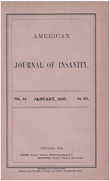Cerebral blood flow changes in limbic regions induced by unsolvable anagram tasks
Abstract
OBJECTIVE: The study addressed the question of whether unsolvable as opposed to solvable cognitive problems activate discrete neuronal systems in the human brain. METHOD: Twelve healthy humans tried to solve unsolvable anagrams. Solvable anagrams and a resting baseline after each anagram task served as control conditions in a within- subject design. Activation was measured with the equilibrium infusion method by using 15O-labeled water and positron emission tomography, with absolute quantitation of anatomically defined regional cerebral blood flow (CBF). RESULTS: Compared to rest, both anagram tasks increased activity in frontal and temporal regions. The soluble task condition increased hippocampal activation and decreased mammillary bodies activity, while unsolvable anagrams were associated with increased CBF to the mamillary bodies and amygdala and decreased hippocampal activity. CONCLUSIONS: A limbic network integrating negative emotion and cognition seems reflected in reciprocal diencephalic and limbic activation with solvable and unsolvable anagrams. Since unsolvable anagrams have been used to induce learned helplessness in humans, this finding may provide an initial step toward clarifying its neural substrate.
Access content
To read the fulltext, please use one of the options below to sign in or purchase access.- Personal login
- Institutional Login
- Sign in via OpenAthens
- Register for access
-
Please login/register if you wish to pair your device and check access availability.
Not a subscriber?
PsychiatryOnline subscription options offer access to the DSM-5 library, books, journals, CME, and patient resources. This all-in-one virtual library provides psychiatrists and mental health professionals with key resources for diagnosis, treatment, research, and professional development.
Need more help? PsychiatryOnline Customer Service may be reached by emailing [email protected] or by calling 800-368-5777 (in the U.S.) or 703-907-7322 (outside the U.S.).



